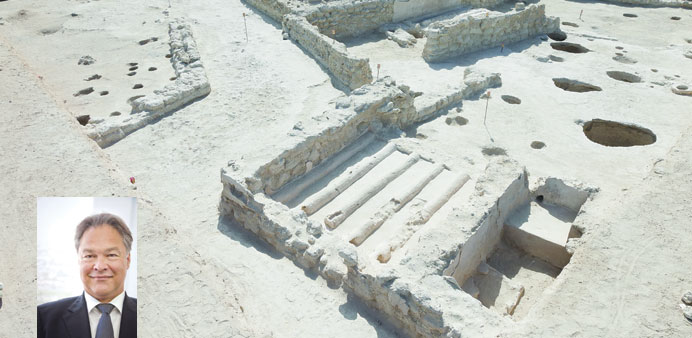By Bonnie James
Deputy News Editor
|
|
Qatar’s tourism sector is all set for a quantum leap with the official opening of Al Zubarah Archaeological Site, the country’s first World Heritage Site, to the public on Friday.
Qatar’s largest archaeological site, which lies on the northwest coast 85km from Doha and 25km south of Al Ruwais, was inscribed on June 22 this year onto the Unesco World Heritage List, an international register featuring 911 natural and cultural properties.
“We are also celebrating the Unesco listing of Al Zubarah,” Prof Thomas Leisten, chief officer of Archaeology, Architectural Conservation and Cultural Tourism Department, Qatar Museums Authority, told Gulf Times.
One of the largest and best preserved examples of an 18th-19th century traditional pearl fishing and merchant town in the Gulf, Al Zubarah is considered “an outstanding testament to the ingenuity and resourcefulness of the Gulf Arabs.”
“Al Zubarah Fort is now the visitor centre, there is a museum in a portacabin outside the fort, and a walkway passing through some of the areas that have been excavated,” the official explained.
The history, excavation and exploration of Al Zubarah will be narrated in a very modern and interactive way in the visitor centre, along with information about the hinterland, the flora and fauna and the settlements in the area.
Visitors can buy souvenirs, including t-shirts and caps, from a small shop in the fort, and hopefully in the not too distant future, jewellery based on ear rings and bracelets discovered during the excavation.
The museum – housed in a U-shaped, 160sq m portacabin outside the fort – will showcase a variety of objects excavated from the site over the years.
“There are beautiful Japanese and Chinese porcelain, metal ware, cannonballs, pearling implements and diving weights…which tells the story of the people who lived in Zubarah,” Prof Leisten said.
One of the attractions of the museum is a ‘little petting zoo of archaeological objects’ which visitors, especially children, could touch.
“When I was a child, somebody let me touch a piece of a pottery bowl that was 3,000 years old and I was amazed. Even though it is only 300 years old here, people would love the experience.”
Also a part of the exhibition is a dhow mast, which was discovered a couple of months ago as a lintel on top of the entrance of the fort.
A food and beverage outlet has been established outside the fort. Comfort stations are ready, with access even for people on wheelchairs.
“If visitors used to spend just 15 minutes earlier in the fort, now they can linger much longer. The southern walkway, the first of the three planned, is 1,400m long and keeps
visitors engaged for half an hour.”
There are explanatory signs on the walkway, demarcated with stakes, in order to prevent visitors from deviating from the path and damaging the ‘extremely brittle’ archaeological remains.
The two other proposed walkways are to focus on other areas and later expand over the whole area, giving visitors a very holistic understanding of the historic town of Zubarah.
“Entry to the archaeological site will be free of charge. The opening hours will be from 9am to nightfall, seven days a week,” the official said.
Brochures and booklets, about the history and salient features of Al Zubarah Archaeological Site, will also be available.
Celebrating the opening, a number of activities has been arranged on Friday and Saturday. Tasting traditional food, learning about pearl diving, listening to traditional music, exhibition of historic films, handicrafts, and national clothing are among the programmes.



